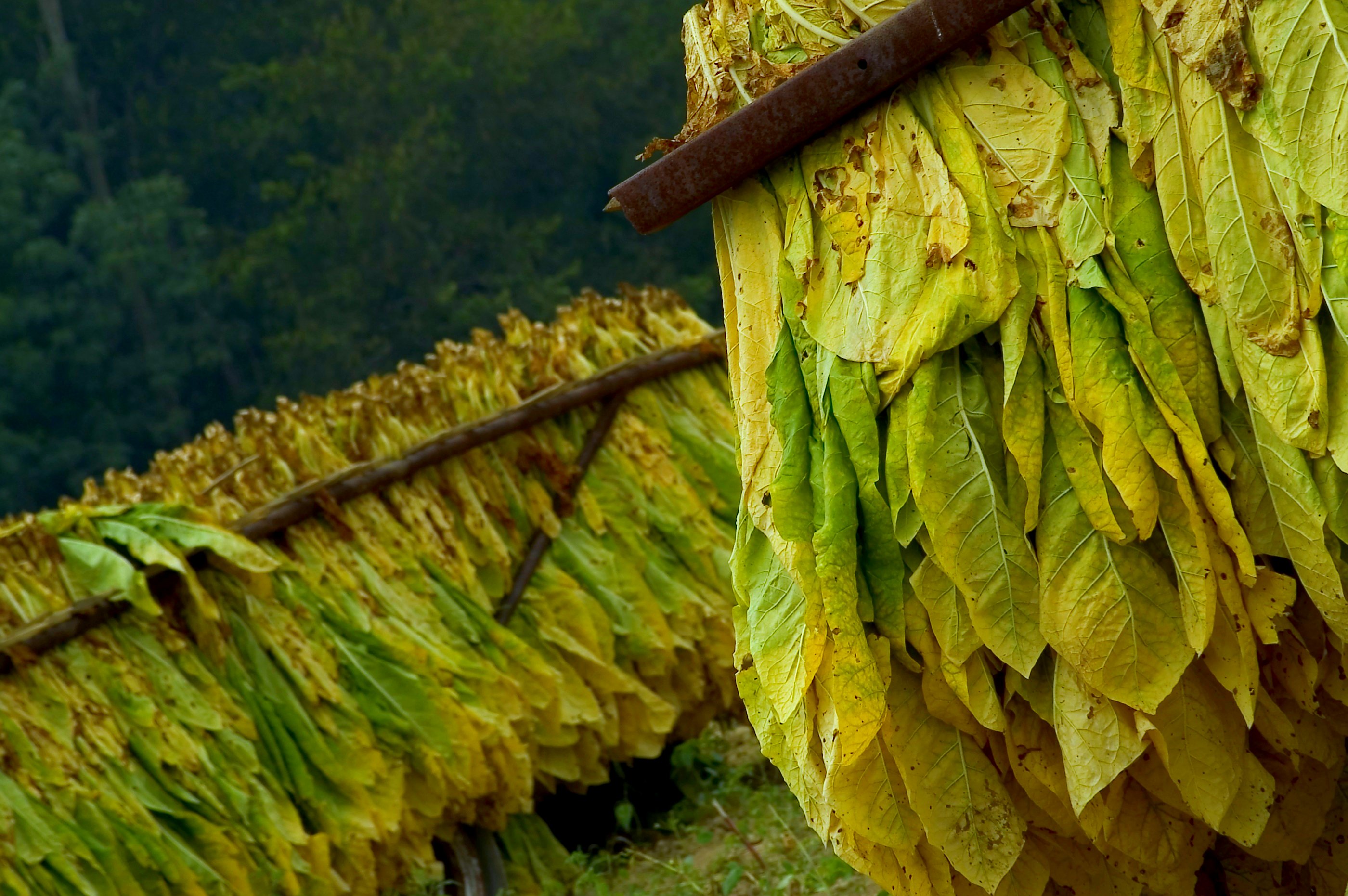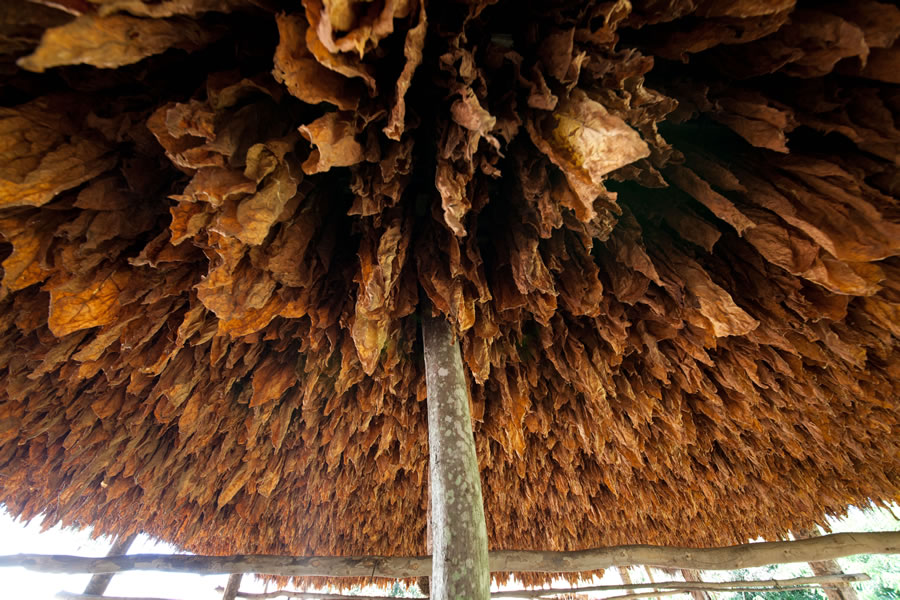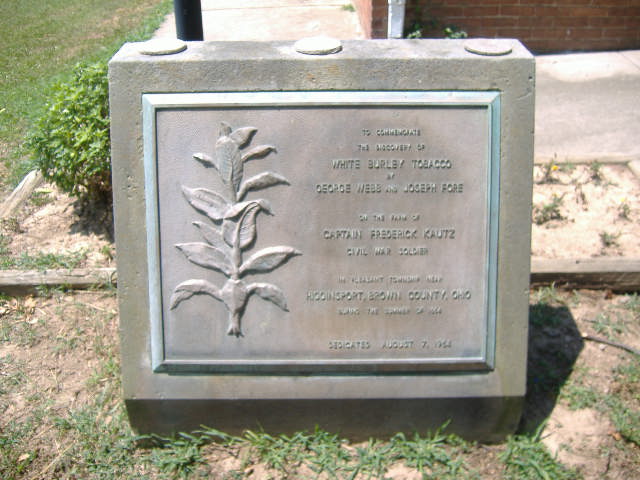Burley is one of most loved and versatile species of the nicotiana tabacum strain. It is used in virtually every kind of tobacco, from snuff and chew to cigarettes and cigars to pipe tobacco. It has the unique property that it is able to absorb flavourings readily and to let those really shine. One of the reasons burley became very popular at the dawn of the “aromatic era” in the 60’s.
The leaves of the plant are medium size. It is grown widely from the mid-Atlantic region of the USA, through the South and into the Midwest. Also burley is cultivated in countries like Argentina, Brazil, Canada, Malawi and Mexico.
There are a few different kinds of burley with different methods of curing:
1. Air cured burley
(sub-categories 1. Light air cured – 2. Dark air cured.)
2. Fire cured burley.
Air Curing: About 90% of all the burley tobacco grown in the USA is air cured. The process is simple: after the tobacco is harvested it is strung on long poles and hung in a barn to dry under natural weather conditions. This air curing process normally takes from four to six weeks. It is completed when the central vein of the leaf is completely free of sap.
Light air cured burley: The top grades of light air cured burley, which are yellow, are referred to as “White Burley”. These larger, thinner middle leaves are those most desired for the manufacture of fine pipe tobacco and premium quality cigarettes. White burley has a fine texture, excellent burning qualities and the ability to absorb large amounts of casings and flavourings. The top and bottom leaves are used in the manufacture of snuff, plugs, twist and inexpensive brands of pipe smoking tobacco. The taste is nutty, sometimes with a bit of a cocoa note.
Dark Air cured burley: Used mostly for chewing tobacco, plugs, snuff and inexpensive brands of pipe tobacco. The lower grades (or heavier leaves) are used in some tobacco mixtures to give the tobacco blend more “body”. The taste is earthy, spicy and cigar-like and the colour of the leaves ranges from light to dark brown.
Fire Curing: In the fire curing process the tobacco is also placed on poles and hung in a barn for a period of three to five days. Then slow fires of hardwood and hardwood sawdust are maintained on the barn-floor until the tobacco is completely dry. The process can take as long as forty days if the weather is very damp. In addition to drying the tobacco, the fire curing process imparts an unusual smoky taste and aroma to the tobacco. Most fire cured burley comes from southern Kentucky and northern Tennessee.
Fire Cured Burley: Usually referred to as “Kentucky Burley”. Its production is essentially for the same use as dark air cured burley. The taste is earthy, spicy and cigar-like with a slightly smoky aroma.
The origin of white burley tobacco is credited to George Webb and Joseph Fore in 1864. They grew it on the farm of one captain Frederick Kautz near Higginsport, Ohio. Seed was used from Bracken County, Kentucky. The captain noticed a different type of light leaf shaded from white to yellow was grown. By 1866, he harvested 20,000 pounds of burley and sold it in 1867 at the St. Louis Fair for $58 per hundred pounds. In 1880 Kentucky produced 36 percent of the total USA tobacco production. First in the country with nearly twice as much tobacco produced as by Virginia.
For me a downside of burley is that it contains a lot of the ol’ lady nicotine. I do not know much about chemistry but I shall try to explain it.. Burley has an alkaline nature (which means that the smoke tends to have a pH above 7). And one of the things that will cause the body to absorb nicotine more and more is an alkaline (or basic) matrix. Which makes sense if you realize that nicotine belongs to a group called alkaloids (morphine also belongs to that group).
However, if you get sick from the nicotine you can do the following:
1. Drink lots of water (8 glasses if you can stomach it) or other healthy beverages (no not beer you Belgium folks!).
2. Take some extra vitamins. They are good for you! Especially if you are trying to clear your body of nicotine. In particular vitamin C is an antioxidant that is known to help in this process.
3. Exercise! Working up a sweat will burn a good deal of those nasty nicotine toxins out of your body.
4. Eat or drink something sweet. Smoking anything high in nicotine will cause your blood sugar to initially rise and then drop. That drop is what causes most of the nicotine issues.
5. Lie on bed and wait for the sickness to pass. After 40 minutes the nicotine loses half of its effect.
The alkalinity of burley has an additional effect: the possibility of tongue bite. Of all the different types of tobaccos, the one most likely to cause bite is Burley. However, it is important to understand that tongue bite is a biochemical reaction. Not to be confused with “leather tongue”, what you might get from smoking too much or too hot. When tongue bite attacks, it feels almost like a muscle cramp. The reaction is caused by the high pH of the smoke and because of that having something to drink that is somewhat acidic (like a dry wine or a soda) can help to lessen the discomfort.
As far as blending goes, little or no sugar is found in the chemical composition of burley. That enables it to absorb great quantities of flavourings or casings. Also, because of the neutral taste and aroma of burley, it blends quite easily with all types of tobaccos. It assumes the taste and aroma of the tobacco or the flavourings with which it is blended. If you would like to lighten a blend you could use some white burley, which will add a bit of sour nuttiness (like a walnut). Dark burley (air and fire-cured) will add a spicy note and maybe a touch of a cigar-like flavor along with a fair amount of vitamin N. So beware if you are a nicotine wuss like me!
There are many, many mixtures that have a bit or a lot of burley in them. So I won’t (and can’t) name them all. But here are some recommended blends:
– Bell’s Three Nuns Original*
– Cornell & Diehl: Burley Flake #3, Exhausted Rooster, Haunted Bookshop
– Edgeworth Sliced (no longer made, old full and sealed tins can be found now and then on e-bay)
– Esoterica Tobacciana: Stonehaven
– GL Pease: Barbary Coast, Cumberland, Jackknife Plug
– HU Tobacco: Nashville County, Dockworker
– John Middleton: Carter Hall, Prince Albert
– MacBaren: Burley London Blend*, Navy Flake*
– Peterson: Perfect Plug*, University Flake*
– Pipes and Cigars: Scotty’s Bulk Blends – Butternut Burley
– Solani: 660 Silver Flake*, 656 Aged Burley Flake*
– Troost Slices*
* Available in The Netherlands





I enjoyed your essay, however I wanted to add a correction if I could. White Burley is a varietal and the leaves, whether top, middle or bottom are all used the same. Leaf location on the plant is important in cigar tobacco but not really in Burley or Virginia. What is known as “Dark Burley” isn’t really Burley at all, however it is air cured in a way similar to Burley so it is called Dark Burley a lot. Dark tobaccos are grown in Kentucky, Tennessee, and Virginia in the U.S. and are used for chewing tobacco and pipe blends. Dark Air Cured is the same as Dark Fired Kentucky it just isn’t fire cured. There is also Virginia Fire Cured, which is the same as Datk Fired Kentucky, in that it is not really what we know as Virginia tobacco today. The dark tobaccos are their own category.
Hello Matthew, thank you for reading and for your comment!
Great reading your bllog post
Thanks!